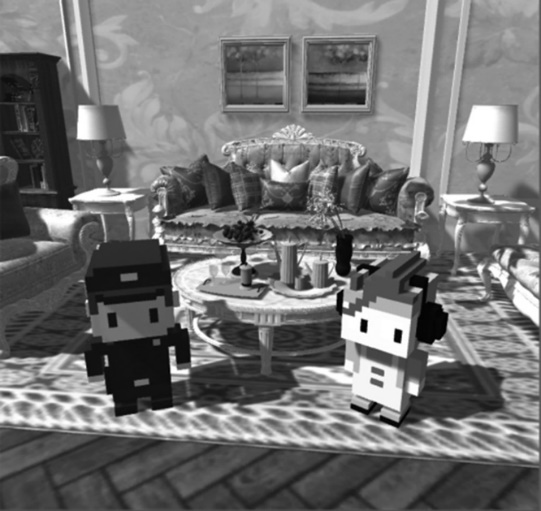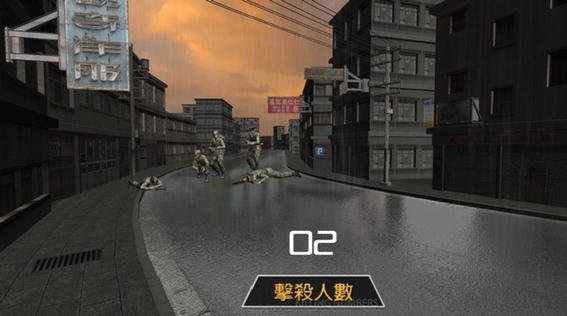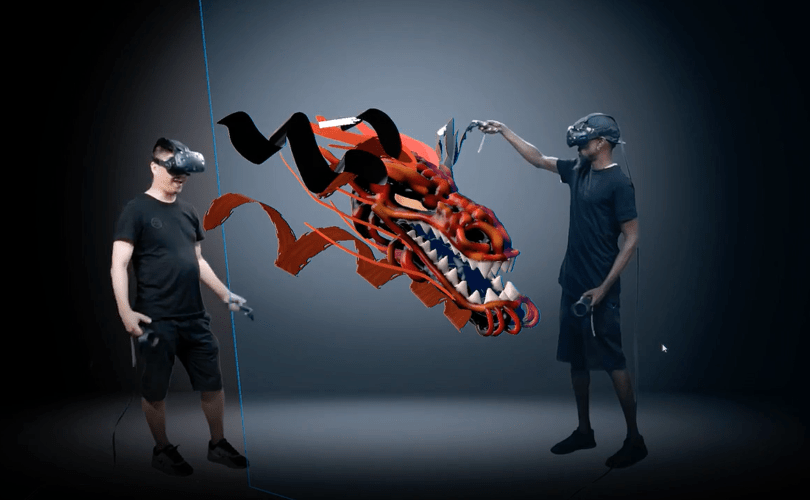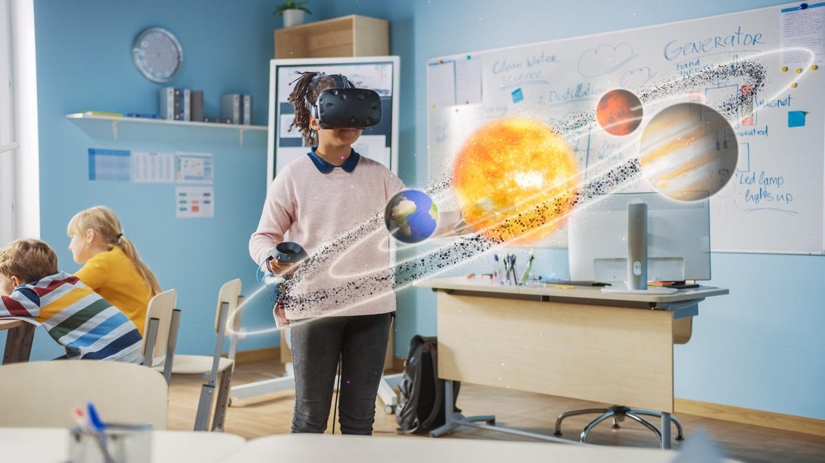1. Introduction
Virtual Reality (VR) is a fast-growing technology and community nowadays. Machines and devices have grown significantly in their calculating power and the efficiency of codes. More and more people started to have VR devices because of the recent influential VR games and VR videos. So, VR devices are becoming more friendly to users and the VR community is expanding.
This essay mainly researches how can VR technology and community help this society. Although VR technology devices were born in the 19th century, it is less influenced than other types of electronic devices. The general public mainly thinks it has no developing space and is designed only for small groups of people. However, we mainly research how VR educates children with games, how VR provides people with fine arts, and how VR helps people with law and political problems. And this essay will probably bring people new aspects and ideas to see the future of VR technology.
2. Virtual reality in educational games
VR, as a simulated world, seems to resemble part of the real society [1]. Amid the era that technology grows fast, there’s an increasing number of people are fond of playing VR games. Immersive experience boosts the existence of education using VR games [2]. VR educational games are based on the teaching concept of “play and learn”. Therefore, classes are supported by VR, AR and other technologies, so that the tedious learning content would be displayed in the form of interactive games, so that the learning process is both educational and entertaining. The key question for most educators is how to add knowledge contents into VR games. Background, gaming experience, rules are some of the factors that form this type of educational games. More and more foreign countries have accepted bring immersive VR games into lessons to gain more attention from the kids.
2.1. Applications of VR educational games
"In Order to Dr." is English education game that solves puzzles. After the participants understand the rules of the game, they need to think over according to the clues and answer the corresponding questions with the use of the props. Their final goal was to successfully complete the final questions and pass the levels. As an English-teaching game, the problem setting is closely related to the English grammar knowledge. Grammar knowledge can be consulted repeatedly during the game; Players complete the prompts, acquire an "escape book" with English knowledge. Finding problems by mouse clicking on items and answering the questions by filling in the blanks to past each question. Multiple levels are set up. Until the final topic is completed, this game is over.
|
Figure 1. Game scene display. |
In the VR Experience Area, through head-mounted devices to interact with games, each aligned object will pop up the corresponding English words and pronunciation; The problem is set based on the English gramma. In the process of repeated review, students are able to have deeper understandings of the knowledge, which makes the player learn knowledge during the game process of active exploration [3]. What’s more, Light-controlled VR technology does not require users to use head-mounted devices, relying on handheld tools and VR imaging technology to achieve the game's sense of control and immersive experience (Figure 1-2). The VR military shooting education game, designed by Bhagat and Liou et al., is a typical research case of controlling the VR system through the laser. The study featured 160 high school students who simulated infrared rifle firing to complete shooting games, and finally conducted a real-field shooting test [4].
|
Figure 2. Game immersive experience. |
2.2. Advantages that VR educational games bring
• Increasing the students’ willing to learn
Most of the traditional courses arranged by colleges and universities are mainly abstract and boring knowledge, resulting in students' low subjective initiative. Under the promotion of VR education games, the teachers can embed the knowledge into the game, so that the learners can understand the knowledge points in the process of participating in the game situations and completing the tasks, so as to obtain an immersive and interactive learning experience. Using VR education games, students have a more intuitive experience and experience of the course content [5].
• Enhancement of Quality of the Classes
In addition, such ways of education very well improve the quality of education. The knowledge in books may not be as good as a memorable class. Sometimes, the knowledge in books is more academic, students cannot empathize, leading to not understanding such subject terms. VR education games can also answer students' questions in a more technological way, just like teachers.
• Releasing pressure of teachers
Various educational activities take up a lot of time, so that teachers are under too much pressure, so the teaching effect is often unsatisfactory, low efficiency. However, if VR education games are put into use, most of the relatively common knowledge can be improved and acquired in the game, which greatly liberates the work pressure of college teachers.
• Improvement of Students’ Initiatives
In traditional education, students usually absorb knowledge through the classroom and are more passive. However, under the VR-based education game, students can explore in a virtual world independently, get inspiration in the game, get the realistic truth hidden in the virtual world, and directly obtain the perception and corresponding knowledge. In the future VR game development, more attention should be paid to highlighting the initiative of students [6].
VR and augmented reality technology can construct for learners virtual learning situation, understanding the learning content, combining education game and intelligent technology, can enhance the application of fun, make it not only as a display, observation and experience tools, but can help learners to learning content have more thorough practice and construction of learning application. The use of VR or augmented reality technology can promote students' body and environment interaction during the learning process. Combining the design of the game link with the cognitive theory, and setting up interesting levels in the implementation process of using the VR education game, it can help the students to better understand [4].
3. Virtual reality in arts education
VR as a powerful tool, could also be easily used in the field of Education, especially, arts education. As the arts is often abstract subjects, like visual arts and music for example. In teaching these subjects, special notations or methods summed up by previous studies is often used, like the music notation in music studies, and Pudovkin’s five editing techniques in film for example (Figure 3). Bringing in such a power tool, teachers now can demonstrate more directly than before, creating a better image of the knowledges in the student’s minds [7].
|
Figure 3. Two people using VR to see a 3D modeled dragon head. |
In these pictures, students are wearing VR headsets to view a 3D model of a Chinese dragon. While using their hand-hold controllers, they can add lines and textures immediately on the model itself. This is absolutely more realistic than just clicking your mouse in a 3D modelling software. Students can get instant response from VR, and they can also rotate freely and move their point of view freely in this virtual world, to see their product from every angle that they can possibly think of.
3.1. In-class improvements
With VR being easier to use, teachers can guide students in a virtual space to simulate the abstract concept, and therefore aid in the learning of students. Students can also be more engaged, act natural, be interested, and lower the pressure while learning. The interactivity between the virtual world and the real world is the key to improve education quality. Abstract concepts can be explained in a direct way: A music student can see directly how a harpsicord works; a visual arts student can walk around in the virtual space and see how a painting technique is used; a film student can see directly how the cameras are setup to shoot all the different angles in a film. Students before can only read what’s on a textbook, going to fieldtrips but only once per semester, or listen to lectures by professors. Now, using VR, every class can be a short field trip to let students feel in person, using their own senses, on the subject itself. Combining visuals, sounds, and activities, VR can be more inclusive, and support learning for all kinds of learners.
3.2. The building of the virtual space
The key to all these positive outcomes is that the VR needs to be real. Before, it is hard to create a detailed scene just by one person. However, the new technologies like the 5G internet, Artificial Intelligence, and cloud computing can very much aid in the creation of VR. The outcomes of these new tools can be more immersive and more interactive than traditional education. Before, students and teachers can only communicate through language; however, with the use of VR, the common language between people from all different races and ethnics, the actions of people, can convey the same message and knowledge to the students, while being more interactive, immersive, and even more convenient for the teacher [8]. In the meantime, teachers can also observe student’s progress, difficulties, and questions in real-time, with the help of these new computing methods, of course. It is hard for arts subjects to take assessments, for example, it is hard to grade a drawing. Some people will say it is good, some will say it is bad. However, VR, combined with big data, can accurately measure the progress of students, and the results can also to be shown in a more graphical and visual way for the teachers to analyze.
3.3. Virtual reality in the case of an epidemic
Virtual classrooms can exist to serve for the learnings when people are forced to do social distancing. As a student who have been though online learning twice, the experience and outcome was not ideal. With the implementation of the virtual classroom, students can also gain a more enjoyable experience during online learning periods. In addition, VR can be use anywhere if there is internet, students at home can still use them as a powerful tool, as an alternative for actual real-life lessons.
3.4. What virtual reality cannot do
For every lesson, there are some problems that cannot be solved by VR. For example, different students could be at totally different levels, extra work will need to be done from the teacher to provide different materials if he or she wished to use VR as the platform for teaching. Also, the immersion of VR could also be a distraction, students will not be concentrated and start to explore something else in the scene.
In conclusion to what this mentioned above, VR in teaching of the arts is indeed a strong tool, by the fact that it is immersive, and it can help the students to better understand the concepts by directly showing them; however, not all problems will be solved using VR, teachers could still face some old obstacles [9]. Teachers in the arts’ field should explore the advantages brought by the new technology: VR and try to avoid worsening the education quality by existing problems. VR is only a tool; educators should not rely on it one hundred percent.
4. Virtual reality in political education
Political education is often referred as any form of learning outside the classroom that involves in the entire society. This can be teaching students in rural areas that won’t be able to gain enough knowledge, or helping them to improve their infrastructures, providing care services. These could be done by people or students organizing volunteering work, and let students involved in and being helpful to the society.
4.1. Why would people need political education?
When people are involved in the political education, it is very possible that they are feeling that they are one of the members of the whole society. Political education not only means that the students are getting trashes, washing clothes and swiping the floors. It is supposed to be helping the disadvantages on both physical and mental way. In the physical aspect, they could be teaching them how to use modern technologies, and helping them to build up basic infrastructures. On the other side, the mental parts are even more important, the students who are involved in political education could be providing education for students in rural areas that don’t have the ability to gain knowledge and get well educated (Figure 4). We could also be helping the elder generations who are left behind during the process of urbanization. The best thing could be done by the students is to provide a listener, an accompany for them, in order to decrease their loneliness in the circumstance that all the younger generations are leaving them.
|
Figure 4. People learning in VR sets. |
4.2. How can VR be involved in this?
It is pretty hard to imagine how can VR be involved in these kinds of circumstances where it is best to be interact face to face. However, the modern technology is available for people to be feeling that the people using VR technologies are side by side with them even if they are thousands of miles away. This is one of the advantages of VR, which could increase the involvement rate of people not available to be volunteering in this activity because of distance and financial problems. These problems often occur in certain circumstances such as the targeted people are very isolated that could take days to travel, or the fee of traveling is simply too expensive for some of the students. VR could enormously decrease the cost and the time needed. Data shows that the VR price in China is around 2000 RMB, but an airplane ticket from Shanghai to Xing Jiang, China will be around 1500 RMB, not counting the return tickets. VR could also decrease the time needed for this kind of activity, since people can start it at home, so the traveling time is cut off. Also, the time needed to stay there and wait until the next activity is also wasted. Instead, all of the activity can be occurred in-house, which could help the students to organize their time better.
4.3. Problems could possibly occur with VR
The most obvious problem of VR is that the infrastructures of the basic comms and peripherals are not settled in rural areas. In China, the network coverage is 99.5%, which means that there are still areas that are not available for this kind of technology to be introduced [10]. Some of the places the fiber channels are just not connect, which makes it nearly impossible to be using VR online system in it. In rural areas, the hardware is also hard to be bought from. Since there are significantly less demand of these highly advanced goods in these areas, it is not hard to imagine that the VR equipment and the base computer for setup is very hard to transport and gather. Lastly, the most difficult one is that the training for theses disadvantaged or the target community in order from them to be able to use VR equipment. Most of these disadvantaged and rural children are often very uneducated, so they possibly don’t even have a sense of the current technology available, so the training process could be both time consuming and money costly. VR could also cause a sense of isolation between the real world and the virtual world.
4.4. Why can VR help with these problems?
As this paper had described before, the more important and critical aspects of disadvantages is their mental well-being, whereas VR could help with this aspect easier. Using VR, the advantage is obviously less time consuming and less costly in terms of financial aspects [11]. VR could be more focused on their mental wellbeing and can provide more and more information given to them using ways that is not possible in the real world such as real time 3d shape graphing. As the explained earlier, the students could also involve in developing and teaching the rural students that don’t possibly have a good education.
VR could be very useful when discussing about political education, however the limitations towards it is very obvious. The final work that needs to be done is the hardwares that should be covering all the world with enough internet and fiber channels. When these are settled, then it is not hard for people to be starting to develop the political education using VR.
5. Conclusion
Through this study, it is found that VR technology has great potential to improve society and help many people to obtain artistic and educational opportunities. VR is already doing a lot for society, even if it's a little hard for us to notice. This article mainly tells readers how VR games educate children, how VR technology presents art for people, and how VR helps people understand political and ideological education. It's about people contributing to society in ways that are different from other forms of games, art, or technology. It can also let more people know what VR technology can achieve and persuade more people to realize the importance of VR technology. Through the continuous development of VR technology, future researchers may discover more benefits VR technology can contribute to the world and how it can change society more significantly. More and more users are joining VR technology and participating in their events and communities, so this can provide more valuable samples and opportunities for future researchers and lead us to study broader and better aspects of VR technology in the future.







